Lentil Insect Pests
Lentil Insect Pests
Cow pea aphid
Biology
- Egg: Eggs are laid on the growing region from which nymphs emerge.
- Nymphs: Eggs hatch into nymphs. The nymphs are slate grey.
- Adult: Adults are small (up to 2.5 mm long) and are shiny black. Females reproduce parthenogentically in the tropics and subtropics.
Life cycle:
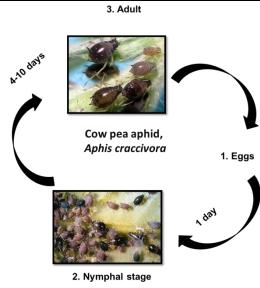
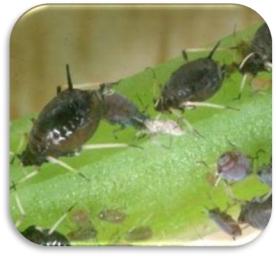
Damage symptoms:
- Cowpea aphids are phloem feeders and inject toxins into the plant while feeding; they most likely reduce vigour and yields. Aphid-feeding also produces honeydew, which grows sooty mould that reduces photosynthesis and makes harvesting difficult.
Ladybird beetles, Syrphid flies, Rove beetle, Damsel bug, Green lacewing and parasitoids such as Aphidius spp. (aphid parasitoid).
Leaf weevil
Biology:
- Eggs: Females lay eggs in the soil near to growing plants.
- Larva: Larvae develop under the soil and are “C” shaped and milky-white with
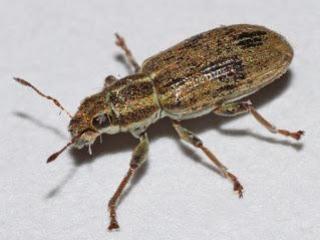 a dark-brown head capsule ranging in length from 3.5-5.5 mm. Larvae develop through five instar stages. After hatching, larvae seek and enter the roots of a lentil plant. Larvae enter and consume the contents of the nodules of the legume host plant.
a dark-brown head capsule ranging in length from 3.5-5.5 mm. Larvae develop through five instar stages. After hatching, larvae seek and enter the roots of a lentil plant. Larvae enter and consume the contents of the nodules of the legume host plant. - Pupa: Pupation takes place in the soil.
- Adults:Adults are slender, greyish-brown measuring approximately 5 mm in length). The weevil has a short snout and feed upon the leaf margins and growing points of legumes
Lygus bugs
Biology:
- Eggs: Eggs are slightly curved and approximately 1 mm long with an eye-shaped cap. After mating and once the eggs mature, females seek suitable host plants, on which lay their eggs. Eggs are laid individually into the stems and leaves of host plants.
- Nymphs: There are five nymphal instars. Young nymphs are li
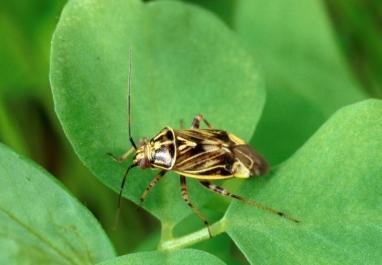 ght green and wingless. Older nymphs develop black dots on the top of the thorax and abdomen. Wing buds are evident in the fourth and fifth instars.
ght green and wingless. Older nymphs develop black dots on the top of the thorax and abdomen. Wing buds are evident in the fourth and fifth instars. - Adults: Adult lygus bugs are about 3 mm wide and 6 mm long. They vary from pale green to reddish brown to black and from fairly uniform color to mottled. Lygus bugs share characteristics with all ‚true bugs, the distinctive, triangular or ‚ 'V'- shaped marking in the upper centre of their backs and membranous wingtips. Adults are active and fly readily when approached.
Cut worm
Biology:
- Egg: The egg is white in color initially, but turns brown with age. It measures 0.43 to 0.50 mm high and 0.51 to 0.58 mm wide and is nearly spherical in shape, with a slightly flattened base. Females may deposit eggs, duration of the egg stage is 3 to 6 days.
- Larva: The caterpillar is rather uniformly colored on the dorsal and lateral surfaces, ranging from light gray or gray-brown to nearly black. The head is brownish with numerous dark spots. They sever plants at the soil surface and cause extensive damage; the caterpillars are cannibalistic.
- Pupa: Pupation occurs in the soil at a depth of 3 to 12 cm. The pupa is 17 to 22 mm long and 5 to 6 mm wide and dark brown. Duration of the pupal stage is normally 12 to 20 days.
- Adults: The adult is fairly large in size, with a wingspan of 40 to 55 mm. The forewing especially the proximal two-thirds, is uniformly dark brown. The distal area is marked with a lighter irregular band, and a small but distinct black dash extends distally from the beanshaped wing spot. The hind wings are whitish to gray, and the veins marked with darker scales. The adult preoviposition period is about 7 to 10 days.
Life cycle:
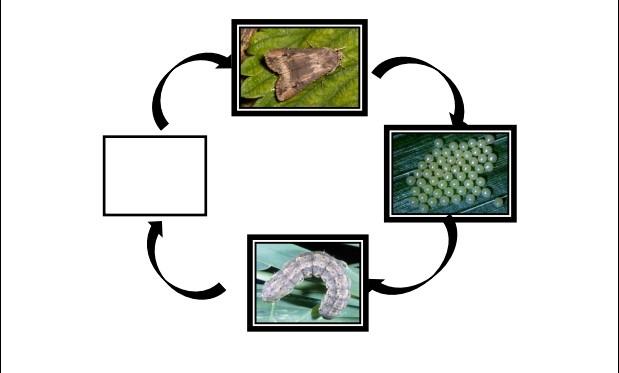
Damage symptoms: Larvae cut off the plant at or just below ground level.
Thrips
Biology:
- Egg: White to yellow; kidney-bean shaped; microscopic in
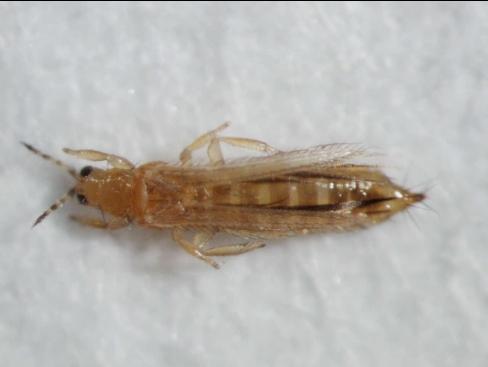 size. Develop within leaf tissue with one end near the leaf surface. Hatch in 5-10 days.
size. Develop within leaf tissue with one end near the leaf surface. Hatch in 5-10 days. - Nymph: Nymphs are active feeding stages.
- Adults: About 0.06 inch (1.5 mm) long; elongate, yellow and brown body with two pairs of fringed (hairy) wings. Mouthparts are beak-like and antennae are 7-segmented.
Natural enemy of Thrips: Minute pirate bugs, Orius spp.
Pod borer: Helicoverpa armigera
Biology:
- It is a polyphagous pest, infesting gram, lablab, safflower, chillies, groundnut, tobacco, cotton etc.
- Egg: Spherical, yellowish eggs are laid singly on tender parts and buds of plants. The egg period lasts for 2-4 days.
- Larva: Caterpillars are of varying in colour, initially brown and later turn greenish with darker broken lines along the side of the body. Body covered with radiating hairs. When full grown, they measure 3.7 to 5 cm in length. The larval period lasts for 18-25 days. The full grown caterpillar pupates in the soil.
- Pupa: Pupation takes place inside the soil in an earthen cell. Pupal stage lasts 7-15 days.
- Adult: Moth is stout, medium sized with brownish/greyish forewings with a dark cross band near outer margin and dark spots near costal margins, with a wing expanse of 3.7cm.
Life cycle:
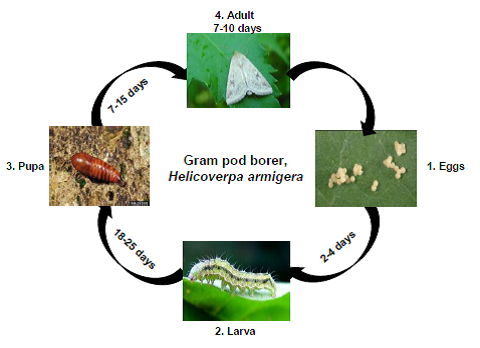
Natural enemies of pod borer:
Common mynah, spider, assassin bugs, Trichogramma spp., Bacillus thuringiensis var kurstaki, entomopathogenic nematodes (EPNs), Yellow wasps, etc
IPM for Lentil
To know the IPM practices for Lentil, click here.
Source: NIPHM; Directorate of Plant Protection, Quarantine & Storage
Last Modified : 3/30/2020
This topic covers information about Fenugreek Ins...
This topic covers information about Chilli insect...
This topic provides information about Coriander I...
This topic provides information about Cherry- Inse...
